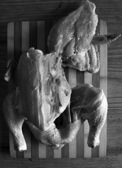Fish Tacos with flour tortillas
(Tacos de pescado)
These tacos are
a classic of modern Mexican Food. Originally the batter was introduced by
Japanese immigrants to the Baja peninsula, and soon the tempura style batter
morphed into a beer batter. This is a pretty quick and easy recipe that is
quite stunning in its outcome.
Serves: 6
Preparation time: 30 minutes
Resting time: 30 minutes
Cooking time: 20 minutes
Ingredients
Flour tortillas
230 g bread flour
60 g vegetable shortening or lard
½ tsp salt
120 ml warm water
extra flour for rolling out
Beer batter
2 garlic cloves, crushed
1 tsp salt
½ tsp fresh black pepper
1 ⅓ cup plain
flour, sifted
1 scant tsp baking powder
375 ml beer
Vegetable oil to a depth of 1 ½ inches for frying
1 cup flour with 1 tsp salt for coating fish
½ cup aioli
½ cup sour cream
1 cup thinly sliced cabbage
¼ red onion, thinly sliced
2 tbsp chopped coriander
½ cup of julienned carrot
500 g boneless, skinless fish fillet like snapper or barramundi,
cut into 5 cm x 1 cm strips
3 limes, cut in wedges
Method
To prepare the tortillas, mix the flour and the lard together, by
rubbing the mixture between your hands until all the shortening is absorbed by
the flour. Add the salt and then slowly add the water and keep kneading the
dough until smooth.
Divide the dough into 12 equal balls. Cover them on a bench with
cling wrap and let sit for 30 minutes.
Place a 25 cm fry pan on a medium heat. Cover a bench with a sprinkling
of flour then use a rolling pin to roll the tortilla out to a 2 cm round. Pick
the tortilla up then gently stretch it out to around 22 cm.
Place the tortilla in the dry fry pan and cook around 45 seconds
on each side. It should have light brown spots and puff up when flipped over. Keep
them covered with a clean tea-towel as they are ready, so they don’t dry out.
Prepare the beer batter by combining all dry ingredients, then
whisking in the beer until smooth. Reserve.
Combine the
aioli and sour cream, season and place in a serving bowl.
Toss the
cabbage salad ingredients together and place in a serving bowl.
Heat the oil in a heavy skillet to 180º. Coat the fish lightly in
seasoned flour and shake off any excess. Dip it completely into the batter
using tongs, and lay it into the oil. Cook until deep golden and crisp, about 3-4
minutes. Drain on paper towel and keep
warm in a warm place while you finish cooking the remaining fish.
Serve
all the fish on a platter with lime wedges to garnish. Present to the table
with the warmed tortillas, salad, aioli and a spicy salsa of your choice.






















